Mo Upakari Bagicha: Improving the Nutritional Status of Women and Children
By Rajib Kumar Roul and Shrikant Mohanta
Background
To address the malnutrition issues among women and children through dietary diversity, Azim Premji Foundation took up a pilot project during 2016-19 in partnership with an NGO Living Farms, in two districts of Odisha, namely, Rayagada and Kalahandi. In this pilot project, all the households covered were made to produce multiple vegetables in nutri-gardens. A nutri-garden is a small patch of land in the backyard of homes, used for growing multi-vegetables using local seeds and without the application of chemical fertilisers or pesticides. It was observed that the dietary diversity in the food plates of women and children of all participating households has increased. This success of the pilot project led the Foundation to scale it up in all 30 districts of Odisha in partnership with Odisha Livelihood Mission (OLM), an autonomous society under the government of Odisha’s Mission Shakti.
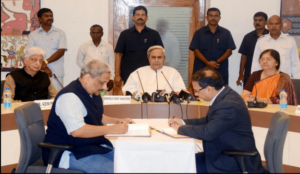

Objectives
The program aimed at improving the nutritional status of women and children in Odisha through:
- Establishing a dedicated nutrition vertical within the OLM system.
- Improving knowledge, skill and attitude of women towards various topics of dietary diversity, nutrition and health through 14 weekly modules of Participatory Learning and Action – Linking Agriculture and Natural resource with Nutrition (PLA-LANN).
- Capacity-building of around 9,000 field-level community cadres of OLM like Community Resource Persons for Community Mobilisation, Krishi Mitras and Prani Mitras, (hereafter, collectively referred to as ‘community cadre’) on nutrition issues.
- Establishing nutri-gardens and livestock (backyard poultry and goat rearing) at household levels to improve dietary diversity.
Implementation
Setting up a nutrition vertical at OLM
At the state level, seven staff members were hired as a part of a new nutrition vertical under OLM. Further, each district was to have a District Project Coordinator (DPC) and two Block Project Coordinators (BPCs) – a total number of 90 staff for 30 districts; but this recruitment has not happened to date.
Geographical scope
All the districts of Odisha were classified into three categories – red, yellow, and green based on the data of stunting of children below the age of 5 years as per the NFHS-4 survey. There are 14 red districts with the highest rate of stunting (>35%), followed by 10 yellow (27-35%) and 6 green districts (<27%) with a relatively lower prevalence of stunting. This project covered most of the red and yellow regions of all the 30 districts of the state.
Coverage of the program
Across all 30 districts, 107 blocks with 750 gram panchayats were identified for project implementation. These 750 gram panchayats are expected to reach 75,000 self-help groups (SHGs) and 7.5 lakh households. Among these 7.5 lakh households, those households which had pregnant or lactating women, children up to 6-years of age or adolescent girls were identified for targeted support. These households were supported in undertaking nutri-gardens and at least one of the two livestock activities – backyard poultry or goat rearing. They received assistance for vegetable seeds, fruit seedlings, etc. It was expected that a minimum of 2.5 lakh households would adopt these practices regularly. Other members of the SHGs were also supported if they indicated an interest or requested support in adopting these practices.
Implementing partners
The implementation of the project is being done by OLM but the Foundation selected three resource NGOs (RNGOs) – Pradan, Harsha Trust and Living Farms to support OLM in the implementation. These RNGOs were selected based on their prior experience with implementing agriculture and livestock initiatives in the state. There were two implementation strategies in the selected 107 blocks – 45 blocks were selected as direct support blocks where one trained resource person from the RNGO was placed on a full-time basis and in the rest 62 blocks, there was a provision of 3-days support per month from RNGO as per the need of the block. The division of responsibilities among RNGOs is shown below.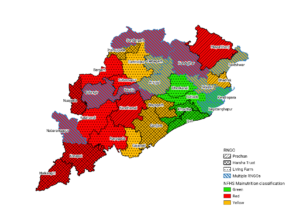
Districts in which RNGOs implemented the program
The RNGOs were responsible for the orientation and training of state and district-level OLM staff hired for the program and training of 240 ‘Master Trainers’ identified by OLM, who further trained the community cadres. At the community level, the RNGOs were responsible for ensuring demonstrations for the various activities under the intervention and developing immersion sites for nutri-gardens and livestock. Further, the RNGOs developed Information, Education and Communication (IEC) material used at all levels of the cascade training on PLA-LANN, nutri-gardens and livestock rearing.
Implementation modalities
The design of the project is to cover 750 gram panchayats in 107 blocks, across all 30 districts of the state. Around 45 blocks in 13 districts were found to be very poor in nutrition status. So, the Foundation decided to put more effort into these blocks (Direct Support Blocks) by keeping one dedicated staff, a Block-Level Resource Person (BLRP) from the RNGO, to support the activities directly. In the other 62 blocks, the RNGO support was designed to be given on a need basis and these were called Need-based Support Blocks. In the Direct Support Blocks, the BLRP gave all support to the OLM cadres in all the three activities – PLA LANN training, nutri-garden promotion and backyard poultry and goat rearing. Similarly, in the Need-based Support Blocks, experts from the three RNGOs gave support to the OLM cadres as and when they asked for assistance. The state-level team of OLM monitored and supervised all the activities and reported the progress to their director and the Foundation as well.
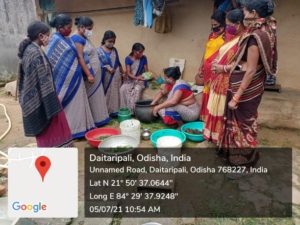
Role of community cadre
The community cadres played a crucial role in implementing the project. The Community Resource Person for Community Mobilisation (CRP-CM) took the responsibility of holding SHG meetings, conducting PLA-LANN meetings in SHGs, helping beneficiary selection for nutri-garden and livestock interventions. The Krishi Mitra (KM) promoted nutri-gardens and the Prani Mitra (PM) undertook the responsibility of promoting backyard poultry and goat-rearing with the beneficiaries. All these cadres were trained by Master Trainers, who, in turn, had been trained by the experts in the RNGOs. In this way, the program reached up to the level of the individual SHG member.
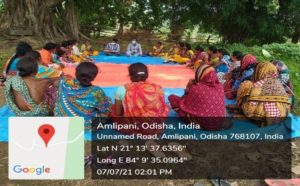
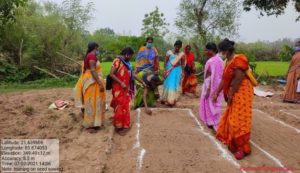
Implementation timeline
This was a 3-year programme, which commenced in June 2018 and ended in May 2021. But the program was effectively rooted only after the appointment of the State Nutrition Team of OLM in October 2018. Due to the non-appointment of 90 district-level staff, the program expenditure was very low till May 2021. Considering all these factors, the Foundation extended the project for another year, that is, till May 2022.
Progress so far
Despite various challenges in the first year of implementation, the project has achieved huge success in terms of promoting dietary diversity among the beneficiaries. Till March 2021, around 3.13 lakh households have grown nutri-gardens in their households. The program got a boost when the state government allocated INR 500 crores through MGNREGA for the promotion of nutri-gardens in 2020. The government also named this project ‘Mo Upakari Bagicha’ (loosely translated, my beneficial garden) which paved the way to converge with other related departments of the government. This program was appreciated by the Niti Aayog and received the prestigious ‘Outlook Poshan’ award from the Vice President of India. Being attracted by its design and success the same model is also replicated in other states (for example, Didi Wadi program in Jharkhand).
The PLA-LANN training conducted in the SHGs, through which awareness has been created among women, has started yielding results. Many women across the project area have understood the importance of nutrition and are breaking the vicious cycle of malnutrition at different stages of their lives starting from adolescence, pregnancy, and lactating stages. Livestock vaccination and egg production through backyard poultry too have picked up resulting in increased consumption of animal protein. Now the Mo Upakari Bagicha program has reached a maximum number of villages in the project area. As a result of 14 module PLA-LANN trainings, the women have started identifying problems of their own villages, are able to prioritise these in terms of importance and urgency and have identified persons from within their communities to initiate actions for solutions. The achievements of the program can be summarised as follows:
- Access to nutritious vegetables from own garden and saving of money during the COVID-19 lockdown period.
- Increase in food diversity and animal protein consumption in participating families.
- Improved participation of women in various meetings (for example, SHG and anganwadi centres). Women were empowered to participate in solving village problems. Health and nutrition have become a subject of discussion in all SHG meetings.
- Feeding practices of rural people changed; they are now aware of adding food of different colours in their daily diet.
- Women are more inclined to add at least six out of ten food groups in their daily food consumption.
- In many villages, the early marriage of girls (under 18 years of age) has been strongly opposed by their mothers as a result of the awareness created through PLA meetings.
- The capacity of OLM cadres associated with the project enhanced through monthly planning and review, support, field demonstrations and field visits.
- Support from the Veterinary Department in vaccinating livestock has increased and ethno-vet practices in the community.
- Convergence with the departments of Horticulture, Panchayati Raj and Women and Child Development has been established. A decision to add nutri-gardens in anganwadi centres has been reached.
- The interest of SHGs members to attend meetings was enhanced through PLA-LANN meetings, and they could identify various issues of health and nutrition. Now they are proactively taking the responsibilities to create awareness among others on various aspects of health and nutrition.
- Community-based decision-making and monitoring systems have been significantly fostering in the villages.
Key reasons for success
Good program design and simple models
The program was designed taking the learning from the Living Farm’s pilot project and field experience of the other two RNGOs. It took around six months to finalise the strategy and implementation plan of the program.
Use of SHGs as the platform to deliver this program
The program is meant for women and children. So, the SHG members took on this responsibility when they understood the importance of the program in promoting good health and nutrition for women and children.
Dedicated state nutrition team to support and monitor the program regularly
This program has helped in establishing a new theme within the OLM system and taking the help of existing community cadres, all these activities were rolled out across the state. Taking ownership and support from district-level officers of OLM and above all, regular monitoring of the program by district collectors and other senior officials has brought about this huge success.
Involvement of existing cadres by providing training and support
This strategy facilitated the program implementation significantly and the government was quite appreciative of it. Also, the coordination among the three driving forces of the program – the Foundation, OLM and RNGOs has been instrumental to its success.
Regular support by three RNGOs
The initial plan was that the three RNGOs will only provide support as technical resource organisations, but due to the unavailability of district-level nutrition vertical staffs, they began to help OLM in each step of program implementation. Community mobilisation, training of trainers, community cadres, handholding support in field demonstration, input procurement, data collection from the field, planning, and monitoring of the program.
Effective IEC materials and mass awareness through PLA-LANN modules
Different types of IEC materials were developed in local languages. The materials developed for the community cadres are mostly in pictorial form in flipbooks. This has helped the easy dissemination of the program and activities. Pusti Mahotsav at the gram panchayat level created mass awareness about the program and the importance of food groups and dietary diversity.
Major challenges
- Non-recruitment of district-level staff.
- Delay in seed and sapling procurement and distribution.
- The convergence with MGNREGA, which is driven by block rather than the nutrition vertical of OLM.
- Giving monetary support to develop nutri-gardens through MGNREGA created allurement which is not in line with the PLA-LANN principles.
- Disruptions in executing PLA-LANN modules due to COVID-19 were a setback for the learning process of SHGs.
- Delay in payment of remuneration to OLM field cadres due to administrative problems was a demotivating factor for the cadres.
Looking ahead
This Kharif season, this program has been planned to reach 430,000 nutrition gardens, out of which 280,000 will be prepared in 43 direct support blocks. There will be around 57,000 landless models of nutrition garden and 297,500 existing households will continue to practice the same. A total of 250 community nurseries have been planned to supply saplings locally. Nutri-gardens will be set up in two thousand anganwadi centres and twelve hundred residential schools.
AUTHORS
Rajib Kumar Roul is Senior Program Manager with the Azim Premji Foundation for the last four and half years. He is a development professional with more than 20 years of experience across various states in India in the field of livelihoods, women empowerment, financial inclusion, nutrition and natural resource management.
Shrikant Mohanta is a Consultant with Azim Premji Foundation for the last two and half years. He is an Agriculture Graduate from Odisha University of Agriculture and Technology and a Postgraduate in Environmental Science and Policy from Clark University, USA. He has more than 25 years of work experience in the field of agriculture, nutrition and natural resources management.

